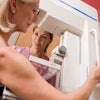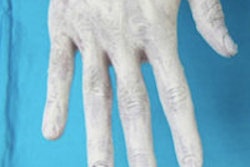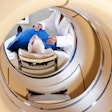The rigorous demands of interventional radiology make it an interesting career choice. There's plenty of contact with patients, and the money is good -- median pay is at least 15% higher than that of diagnostic radiologists in the U.S., according to a 2002 survey by the American Medical Group Association in Alexandria, VA.
But interventional radiologists aren't in it for their health. The jobs have traditionally been difficult to fill, owing in part to perceptions that scatter radiation produced during interventional procedures can potentially endanger the radiologist. Studies have offered some evidence supporting this conclusion.
In the Journal of Vascular and Interventional Radiology, Drs. Tamami Haku, Takaaki Hosoya, and colleagues from Sanyudo Hospital in Japan discuss the radiation protection system they designed and tested as a potential solution to stray x-rays that occur during interventional procedures of the upper abdomen. Depending on the radiologist's position vis-à-vis the patient, the system was effective in reducing radiation scatter around the angiographic apparatus from 35% to as much as 100% (JVIR, August 2002, Vol. 13:8, pp. 815-822).
Radiologists perform a growing number of upper abdominal interventions, including balloon and stent angioplasty, thrombolysis thrombectomy, and dialysis access, and they face special risks in performing their work, according to the authors.
"The operators and assistants must stand near the upper extremity of the patient when the operators use a catheter and guidewire for procedures requiring access via the arm," they wrote. "Compared to interventions in other regions, which require the femoral approach, the closer proximity to the radiation field and the x-ray tube during interventional therapy of hemodialysis access and venography of the upper extremity results in greater radiation exposure to the operators and assistants."
The group cited several studies suggesting that the radiation dangers are real. A study by Berrington et al found a 41% higher incidence of cancer deaths among U.K. radiologists who had worked 40 years or more, compared to physicians as a whole (British Journal of Radiology, June 2001, Vol.74:891, pp. 507-519).
There was no evidence of an increase in cancer mortality among radiologists who began practicing after 1954, in whom radiation exposures are likely to have been lower due to better radiation protection, they added.
Last year, a review by Schubauer-Berigan and colleagues at the National Institute for Occupational Safety and Health in Cincinnati, reported a small but meaningful increase in leukemia among certain nuclear power workers in the U.S. and Europe, who typically receive low-linear-energy transfer radiation doses (Occupational Medicine, April-June 2001, Vol. 16:2, pp. 271-287).
However, a 1993 study reported that the mean annual effective radiation dose for interventional radiologists was 3.16 mSv (316 mrem), with a range of 0.37-10.1 mSv, approximately equal to the natural background dose of 3 mSv per year. Niklason et al concluded that the annual radiation risk of fatal cancer would be less than one per 10,000 for almost the entire career of an interventional radiologist (Radiology, June 1993, Vol. 187:3, pp. 729-733).
Haku and colleagues cautioned that calculating lifetime exposure is not yet possible for a profession that has only existed for the past 20 years, and that spiraling procedure volume brought about by an ever-increasing range of procedures is anything but a good sign. A protection device had been studied for abdominal imaging, they wrote, but prior to their study none had been designed for the upper extremity.
The radiation protection system consisted of two acrylate image intensifier (I-I) hoods with a 0.35-mm Pb equivalent to protect against scattered radiation from the patient's extremity, and an x-ray tube cover constructed of a lead curtain (0.35-mm Pb equivalent) to shield against backscattering radiation from the catheter table.
The x-ray tube cover was favored over a lead curtain. In order to provide equivalent protection, a lead curtain would have had to surround the table completely, and the table would have had to be reinforced in order to support the additional weight.
The researchers measured scattered radiation using an extremity phantom and an ionization dosimeter, both with and without the radiation protection system. In order to approximate measurements at different points on the radiologist's body, they measured radiation scatter at three different heights from the floor: 50 cm (operator's lower limbs) 100 cm (operator's abdomen), and 150 cm (operator's head/neck).
The components were measured in several combinations: with no radiation protection device, with only the I-I hood, with only the x-ray tube cover at a height of 95 cm, and with both the hood and the tube cover at a height of 95 cm.
Exposures were acquired on a digital subtraction angiography device (CAS-8000V and DFP-2000A, Toshiba Medical Systems, Tokyo, Japan). The device consisted of a moveable C-arm, x-ray tube unit, and cesium iodide input image intensifier with multimode input diameters and a high-resolution television system, the authors wrote.
According to the results, the lowest scattering dose rate at the operator's position was achieved using both the I-I hood and x-ray tube cover, which decreased the radiation dose at heights of 50 cm, 100 cm, and 150 cm by 97%, 34%, and 100%, respectively. Using the x-ray tube cover alone, dose was reduced by 97% at a height of 95 cm. Using the I-I hood alone, the dose was reduced by 81% at a height of 150 cm, the authors reported.
At the vertical position, scattering dose rates were reduced at all measuring points using both the I-I hood and the x-ray cover at a height of 95 cm using the radiation protection system.
Around the angiographic apparatus, the dose was again lowest when both protective components were used. At 50 cm in height, the dose reduction ranged from 70% to 99%, with a reduction ranging from 8% to 73% at 100 cm.
"When the x-ray tube cover was set up close to the table, the scattered radiation below the table was markedly reduced at the assumed operator's position," the authors wrote. "This result indicated that reduction of scattered radiation below the table could be achieved with sole use of the x-ray tube cover positioned close to the table. With the radiation protection system, scattered radiation below the table could also be reduced around the angiographic apparatus."
The system did not sufficiently reduce scattered radiation at a height of 100 cm around the assumed operator's position (46% to 73% reduction) they noted. This height, where the operator's hands are positioned, is an important factor considering the dose limits to the hands of 938 μR/min established by the International Commission on Radiological Protection.
As a result, "the hand dose becomes a limiting factor in operator performance, as in other angiography and interventional procedures of the cardiac or head/neck region," they wrote. So while the dose protection of the authors’ system does not equal that of protective gloves, it still provides a measure of protection for operators working without them.
The authors encouraged manufacturers to begin working to develop a commercial version of the device, concluding that "operators would avoid unnecessary radiation exposure by using the radiation protection system."
By Eric BarnesAuntMinnie.com staff writer
September 13, 2002
Three simple steps can reduce interventional x-ray dose, April 9, 2002
New protective devices shield interventional radiologists, February 5, 2002
CT dose study is good news for interventional radiologists, October 5, 2001
Low-dose CT fluoroscopy minimizes interventional exposure, July 30, 2001
Proposed U.S. rules increase safety and cost of fluoroscopy systems, August 16, 2000
Copyright © 2002 AuntMinnie.com


















